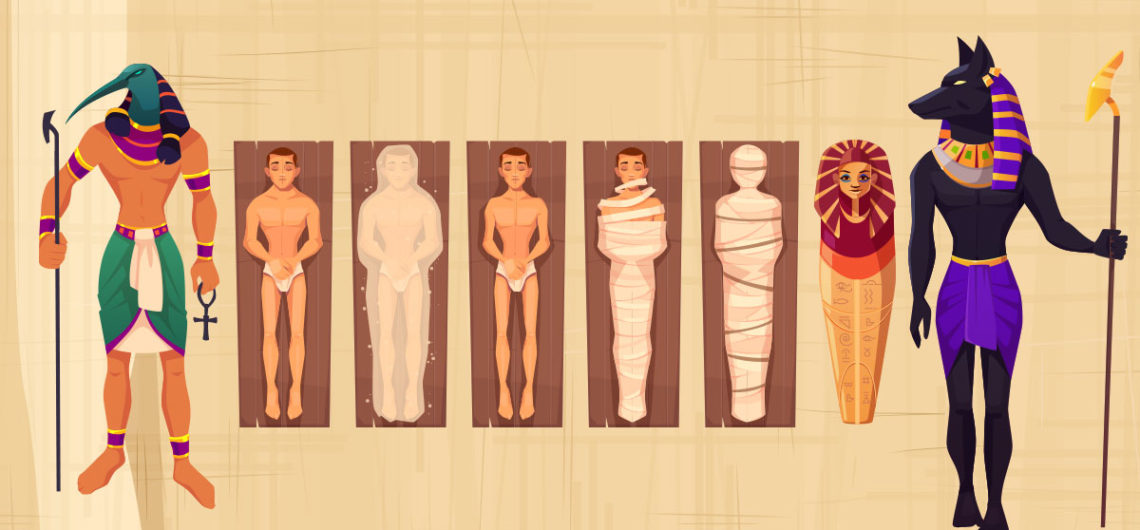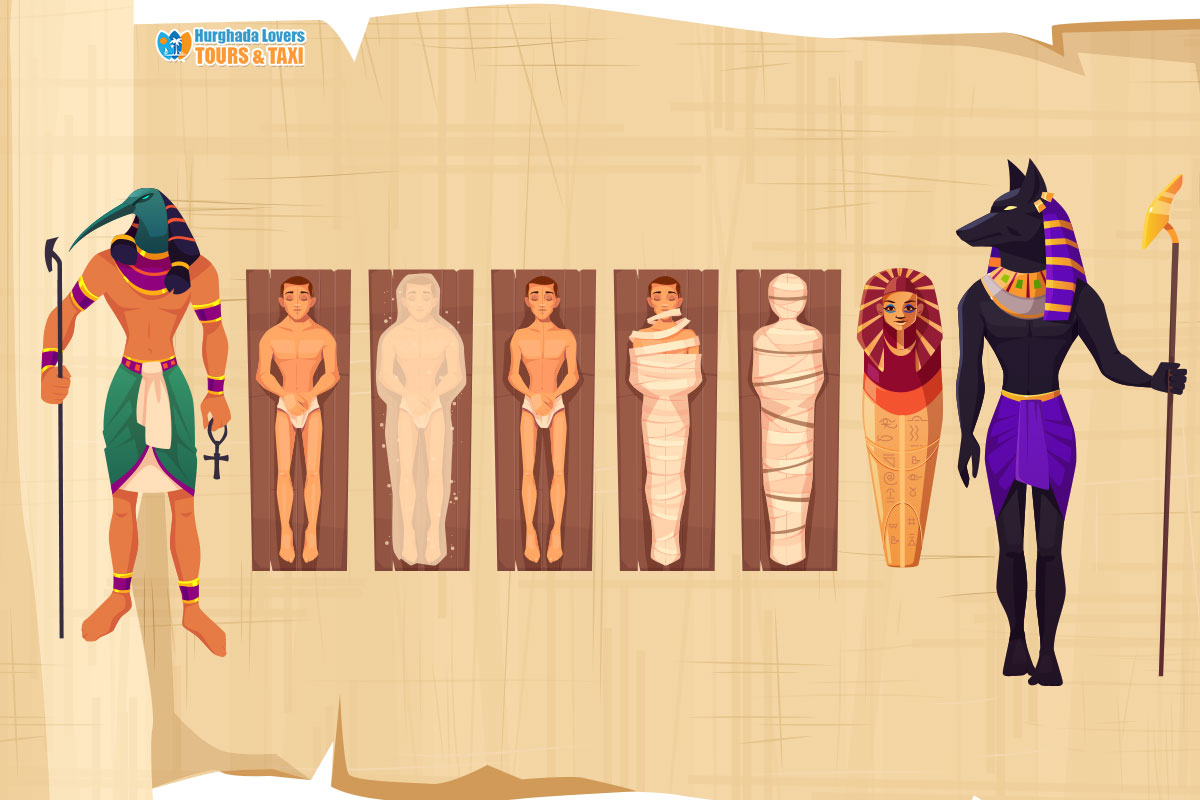Mummification in ancient Egypt | How were ancient Egyptians mummified? Facts, Secrets Egyptian Mummies, What is the secret of mummification among the Pharaohs? Discover the Secrets of how the Pharaohs buried their dead in ancient Egypt Step by Step, what tools were used in the Mummification process, and more about How to mummify a pharaoh
The Mummification of the Pharaohs | the facts and secrets of the ancient Egyptians of ancient Egypt and more about Ancient Egypt History.
Mummification in ancient Egypt
find out the facts and what instruments were used in the Mummification Process to preserve the body after the death of the Pharaonic mummy and other secrets of the Pharaonic civilization.
The Egyptian origin of the word embalming in the Pharaonic Civilization language “The ancient Egyptian Pharaonic language“: “wet” or “wety” which means white or egg in terms of linguistic root, but it means in terms of use (wrapped in white scrolls).
When a person dies, he or his relatives wear it to the seasoned, who present three wooden models representing the three types of embalming, the most expensive of these methods that follow the method of mummification of the body of God Osiris “The Egyptian Gods“, and the second method is cheaper, and the third method is the least that can be done and costs little money.
How did the ancient Egyptians mummify?
If the parts agree to hand over the body to the mummified and begin their work by removing the brain from the skull with a metal machine with a twisted limb, then wash it from the inside with date wine and fragrant liquids, and then polish it with irrigated powder and other substances with a good scent.
If they have finished the viscera and soft elements, they place the whole body in the salt of the tarantula for 70 days, and if this period ends, thoroughly wash the body, and then wrap it in a linen cloth after soaking it in an adhesive liquid.
What worries us about the mummification process here are its religious rituals, which begin in its early days with the time of washing with water from the Nile River to remove excess salt, and it was a ritual work to the fullest extent, because the Egyptian saw it as a symbol of the myth of the creation of the sun from the water of the Nile and the retreat of floodwaters.
Common images of these rituals are visible in the Pharaonic Egyptian Tombs or The Coffins in Ancient Egypt of The New Kingdom from Eighteenth Dynasty of Egypt, and the deceased sits on a large jar, bathed in a jet of water flowing on it.
What is the meaning of the mummification?
The Greek origin of the Greek word embalming:
- Mummification, which derives from the word “mummia”, a word derived from persian origin, which means “black”, because in the 5th century BC, they noticed that the bodies had turned black after mummification, which was not Arab, but transformed by the Arab vote (mummy).
- The Greek word embalming, that is, drowning the body in balm, a substance commonly used in Greek times in the mummification of bodies, that is, the term is derived from the substance used in embalming.
The Arabic origin of the word embalming in Arabic:
It is from the word ” honut ” are preservatives used in the fat of the coffin and body such as amber, musk and eucalyptus, and from the word ” honut ” came the word ” honuti “, the person who paints the coffin and treats the body before burial.
There is no doubt that many peoples, before the Egyptians, used embalming in part in the application of their otherworldly rituals or to preserve the bodies of animals, but the Ancient Egyptian people found a strong intellectual and religious motivation to invent mummification and make it a funerary practice for kings and nobles first, then for the public of the people.
What was the importance of Mummification in ancient Egypt?
In this work, it preserves the body to the other world after death, when death that takes away the soul for a while, as they believed it, then the soul returns to recognize her body and begins the journey to the other world as in Ancient Egyptian religion.
When a person dies, his family and relatives wear it to the seasoned, who exhibit three wooden models representing the three types of embalming, the most expensive of these methods that follow the method of mummification of the body of Osiris and the second method is cheaper, while the third method is the least expensive that can be done and costs little money.
What is the ancient practice of Mummification in Pharaohs?
If the parts agree to hand over the body to the mummified and begin their work by removing the brain from the skull with a metal instrument with a twisted tip, then wash it from the inside with date wine and liquids with a fragrant smell, and then fill it with bitter powder and other fragrant substances and then if they are done with the viscera and soft organs.
Religious rituals continue through spells read at each stage of mummification, with two Papyrus mentioning some spells accompanied by instructions that we recommend removing the nails and fingers before wrapping them, accompanied by a special spell for the mummy to recover afterwards, and wipe the head with oil in a final step with a number of coils irradiated with oil or resin and take care of the spells that are supposed to cool the senses and so on on the rest of the limbs.
What items were used in Mummification in ancient Egypt?
- 10 cm palm leaf embalming brush
- 6.8 cm bronze scissors
- 7.5 cm tweezers
- Two drills, one with a wooden hand and the other with a healthy hand.
- Bronze needle with a linen thread.
- Bronze chisel
- A bronze peat from Roman times.
- 13.5 cm long bronze spat
- Bronze spoon
- Two scalpels, one 17 cm long and the other 7.14 cm long
Most of these tools are made of bronze one of Ancient Egyptian Metallurgy, with the exception of the embalming brush made of palm leaves, and these tools are likely to be used in mummification processes as they are included in embalming residues inside and outside cemeteries.
The inner bowels were preserved in Canopic jars, a stone, wooden and pottery pot in which the bowels of the deceased were placed to know more about Industry in ancient Egypt, each in the form of the four sons of God Horus: Imesty with the head of a human being, Hapi with a monkey head and Kebeh Senu Ef with a falcon head, and Dwa Mut Ef with the head of a jackal protected by the goddesses of escorts, respectively: God Isis, God Nephthys, God Serket and God Neith, and we addressed the theological relationship between the gods, members and destinations of the world.
Who is the god of Mummification in ancient Egypt?
God Anubis was the god of the mummified, and the God (Apollo) who with the head of the jackal was a familiar face in funerary rituals and beliefs as well as the gods (Osiris, God Hathor, Merit Sejeret)… etc.
What are the secrets of Mummification in ancient Egypt?
The mummified body is then placed in a coffin or coffin decorated with images of the gods that will help it resurrect after death, and its types differed depending on the status of the deceased and his economic level as in Social Structure in Ancient Egypt, often taking the form of the god Osiris.
How were pharaohs typically buried?
“The funeral rites took place in the middle of a kind of funerary religious dance and tambourine ringing as in Music in Ancient Egypt, and the High Priest of Amun carried the coffin and the canopic box, and flowers were piled around the coffin through which they crossed the Nile.
The women are relatives of the deceased, Andlin, carrying the coffin of the last Pharaonic Ushabti Statues of the deceased and carrying the rest of the funerary boats and Funerary Equipment and the family of the deceased, the boat carrying the body was preceded by another boat containing a number of women in the direction of the body, standing at the front of the boat one of the members of the family of the deceased and shouting the rudder to head west towards the country of justice.
How were Egyptian pharaohs buried?
Mummification in ancient Egypt. The third boat includes the relatives of the deceased male, while the fourth boat has friends and colleagues of the deceased carrying their sticks in their hands, and they came to pay the last tribute to the deceased, and put in his grave their gifts carried by their waiters in front of them from bouquets of flowers, Food in ancient Egypt offerings, etc.
On the west bank of the Nile, the last funeral ritual begins, and the men walk in the foreground and are followed by women, and during the funeral, the priests burn incense in front of the mummy and sing sad hymns to the deceased as in Ancient Egyptian Literature, often leading a group of dancers named Moe, performing a religious dance for the deceased in special clothes with two symbols representing Isis and Nephtis representing the tragedy of Osiris.
The influence of Egyptian medicine on Greek and Roman medicine: Mummification in ancient Egypt
Perhaps one of the most important manifestations of the influence of Medicine in ancient Egypt on Greek medicine is what we find first in the great correspondence between the Egyptian papyrus and the writings of Greek doctors such as Dioscorides 50 B.C., Galinos 130-200 B.C., and Pliny 73-79 B.C., and it is known that many Greek doctors studied in well-known Ancient Egyptian science schools who studied the medicine and other sciences.
Mummification in ancient Egypt. the origin of the Greek word pharmacy comes from the word “var-ma-k phar-ma-ca”, which means “healing donor”, which was found engraved on the basis of a statue of the God Thoth that was carved in Memphis, which was spread by the Greeks by the word The Roman word Apotheca, which refers to the profession of pharmacist, may have been taken by the Romans from the city of Abu Tig in Upper Egypt, also called Sepalsia as in Geography of ancient Egypt.
In its early days, Greek medicine relied entirely on Andy’s Egyptian medicine, and it was a combination of religious medicine and clinical medicine, and it only took shape in clinical direction with the advent of Greek physician Hippocrates of Kos “Hippocrates II”, who rid medicine of its religious and philosophical deposits and made it advance in the scientific direction.
However, Hippocrates is not the pinnacle of Greek medicine, but the Alexandria School is the pinnacle of this medicine, having grown up in 300 B.C.C., mixing the tradition of ancient Egyptian medicine with scientifically oriented Greek medicine, and gave birth to three senior doctors (Theofrastus, a physician and botanist, Herophilus, a physician and anatomist, and Erasstratus, a physician and scientist). This medical school became the basis of intermediate and then modern medicine.
Note: Information and secrets of Mummification in ancient Egypt are being added…
References Mummification in ancient Egypt: The Book of Egyptian Civilization, Egypt
Hurghada Lovers best Tour Operator to provide daily tours to visit the Tourist attractions of Luxor by Hurghada to Luxor Day Trips and Cairo by Hurghada to Pyramids Day Trips to discover the secrets. Book online when you come to Hurghada, El Gouna, Sahl Hashish, Makadi Bay, Soma Bay.
The Mummification of the Pharaohs | the facts and secrets of the ancient Egyptians of ancient Egypt.

